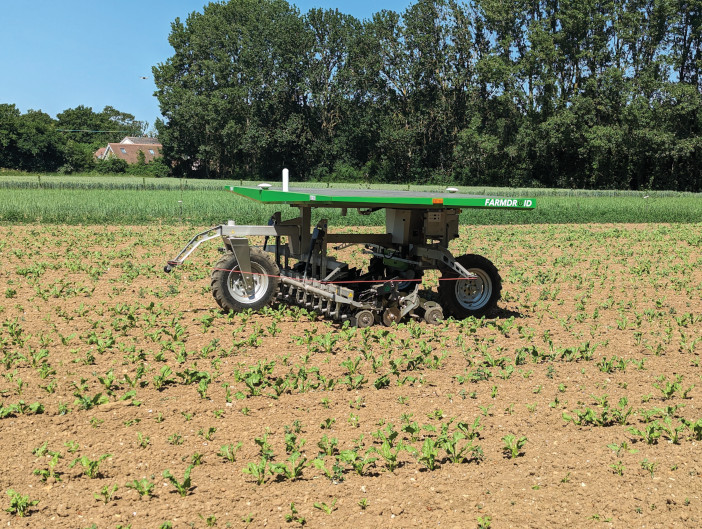As the Writtle University College regenerative project continues to develop, we headed back down to Chelmsford to keep abreast of the progress.
When we first came down to Writtle University College (WUC), the institution was working with dealership Ernest Doe to trial the latest technology in a regenerative system, involving students of its Regenerative Agriculture course to develop a farming system that could be rolled out at scale, and which would satisfy the increased focus on environmental measures such as biodiversity and carbon capture.
As the university reclaimed land which had previously been cropped and worked by a neighbouring farmer, the students plotted out a cropping regime, which included a cash crop of fodder beet (to be fed to the university’s livestock) which was established with the Opico FarmDroid. Also, in the field would be two tree alleys of fast-growing fruit varieties, with strips over diverse cover crops on either side of the trees.
Heading back down to the campus, we were able to see how the project had progressed. Henry Matthews, the course manager for agriculture at Writtle University, gave us an overview of the developments. “It’s given us the ability to take that classroom learning and put it to practical use,” he explained.
The project has been supported with funds from the Essex National Farmers’ Union (NFU) Charitable Trust and is aligned with the Sustainable Farming Incentive and Countryside Stewardship scheme. “Regenerative farming is all about circularity, so the project has been designed as such. As the fodder beet we’re growing here is fed to the cattle, the manure will be spread back onto the field here. Beyond the first row of trees, we’ve also got a plot of naked barley, which we’re working with Hodmedod’s to see the possibilities to take that through to human feed,” Mr Matthews said.
Almost acting as a control plot, there is also a commercial plot of wheat (grown and managed by the neighbouring farm) beyond the second tree alley. Mr Matthews noted that this will give some indications on the margins of regenerative farming. “While the wheat will no doubt yield more than the naked barley, it will also cost more to take through to harvest. It will be interesting to see how the margins compare when the lower cost of establishment and the premiums for our ancient grain are considered.”
The cost of establishment and inputs for the fodder beet have also been reduced thanks to the FarmDroid, which is solar-powered and autonomous, using a GPS signal to monitor exactly where seeds are placed so that it can accurately and mechanically weed between the rows and the plants.

“I think there’s a misconception that regenerative farming is somehow going backwards,” said Mr Matthews. “Of course, we are looking back in some regards but technology like this will play a key role in the future of farming, especially to reduce costs and the use of chemicals, and to replace the labour that our industry is missing.”
Alex Hepburn, farm manager at WUC, told us that the FarmDroid was completing its third pass as a weeding robot since the crop was established. The first pass was done blind, using the GPS location of each seed, while the second and third were done when the crop was visible.
“Because we’ve never assessed the soil in this field before, it’s difficult to quantify how clean the ground is,” Mr Hepburn said. “But the crop looks clean at the moment, and we’ve used nothing but the FarmDroid.” He also added that weeds were visible around the tree alleys, where the cover crop was yet to be planted, so there clearly was a weed presence in the field.
“One benefit has been that I haven’t had to really think about this field,” he said. “We’ve put a couple of applications of fungicide and herbicide on the naked barley, which is time we could have spent doing something else, whereas the FarmDroid has just sat in the field and worked when we’ve felt some action needs to be taken.”
He concluded that he was excited about the prospect of stacking incomes on each acre of land. “The project is really starting to pick up speed. Next season, we’re going to be integrating a larger field into this, but you can already see some of the benefits.
“For us, this is a manageable patch of fodder beet, and then we’ve got the naked barley and the cherries, plums, pears and nuts growing on the trees. The dry weather we saw after planting has had an impact, but this field has several viable incomes when it comes to harvest. Even more than what we’ve established when you consider the commercial wheat.”
With the FarmDroid handling crop care in the fodder beet, and the naked barley having minimal inputs, the project is now waiting for harvest. “There’s going to be a lot of interesting comparison points,” concluded Mr Matthews. “And once we have the results from this, we can start looking at integrating livestock and increasing the scale again.”
For more information on the FarmDroid go to www.opico.co.uk

